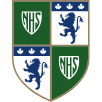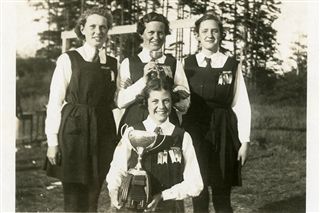The roots of the house system was a feature introduced into the founding schools, Norfolk House and Glenlyon, early in their development. It was modelled on a practice that was originally introduced in public schools in England. Each student was allocated to one house at the time of enrolment, to provide connection and identity with a house for the opportunity to compete with other houses in sports and other ways, thus providing a focus for group loyalty.
At Norfolk House it wasn’t until 1933 when the gymnasium was completed next to the Main building at Pemberton Woods that house competitions got underway. The students were divided into three houses: Caister, Walsingham and Wymondham—names recalling market towns in the county of Norfolk, England. Dereham was introduced in 1965.
Each house at Norfolk would elect a house captain, while two mistresses were allocated to support the captain’s role. Part of the house captain’s responsibilities were to keep a house diary and provide unique banners to help the cheerleading activities.
The Challenge Cup for the Cock House at games—later called the House Cup, was first awarded at the end of the 1943/1935 school year.
At Glenlyon Preparatory School, Major Ian Simpson adapted the house system to reflect his own needs, as he wanted structure for administrative needs and also to provide the students with a sense of belonging in a house group. Major Simpson established two houses (Blue and White) and moved students around every September to better create two ‘competitive’ groups. Initially, there was no House Cup and academics and student behavior were not considered in points scoring.
In 1944 Glenlyon was presented with a cup by H.R.C. Booth (Father of Michael R. Booth who attended Glenlyon from 1939 to 1943). This cup was presented as the House Cup for Glenlyon at the end of the 1943/1944 school year.
With an increase in enrolment in the early 1960s at Glenlyon it was necessary to increase the number of houses first to three and shortly afterwards to four. The houses were renamed Fraser, Mackenzie and Thompson with Douglas being added as the fourth house a year later. The associated colours were also changed to blue, red, green and yellow.
In 1986 when Glenlyon and Norfolk amalgamated and became Glenlyon Norfolk School, the house names of the founding schools needed adjustment. This was resolved by combining them—Wymondham-Douglas, Walsingham-Thompson, Dereham-Fraser and Caister-Mackenzie.
Initially, each campus operated their house ‘competitions’ on a points scheme that included one or more of the following recorded aspects of school life: inter-house activities, academic effort and achievement, participation and behaviour.
As time passed there was a gradual distancing from academic, effort and ‘traditional’ house competition like track and field and swimming. Dwindling interest and participation by the students and concern over use of academic time contributed to these changes.
Even though some great and fun activities were introduced, the enthusiasm waned—particularly in the Senior School and the House Spirits Awards and Pooley Cup (which had become the House Cup) were retired.
Although the Junior and Middle Schools maintained many of their house activities, the Senior School unfortunately did not. However, efforts to revitalize the house system are underway with House Captain elections at the Senior School and a focus on fun and participation for all!





